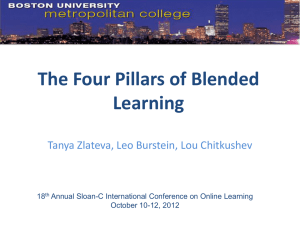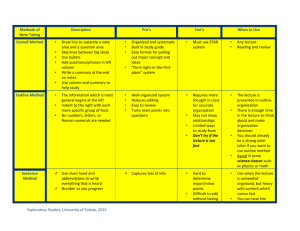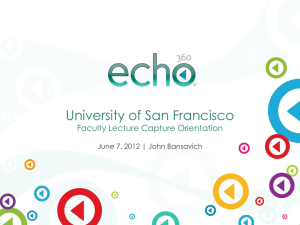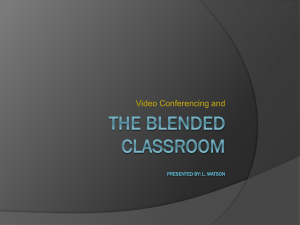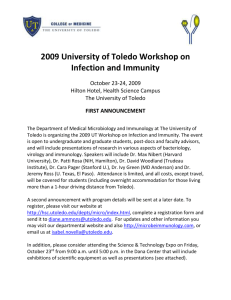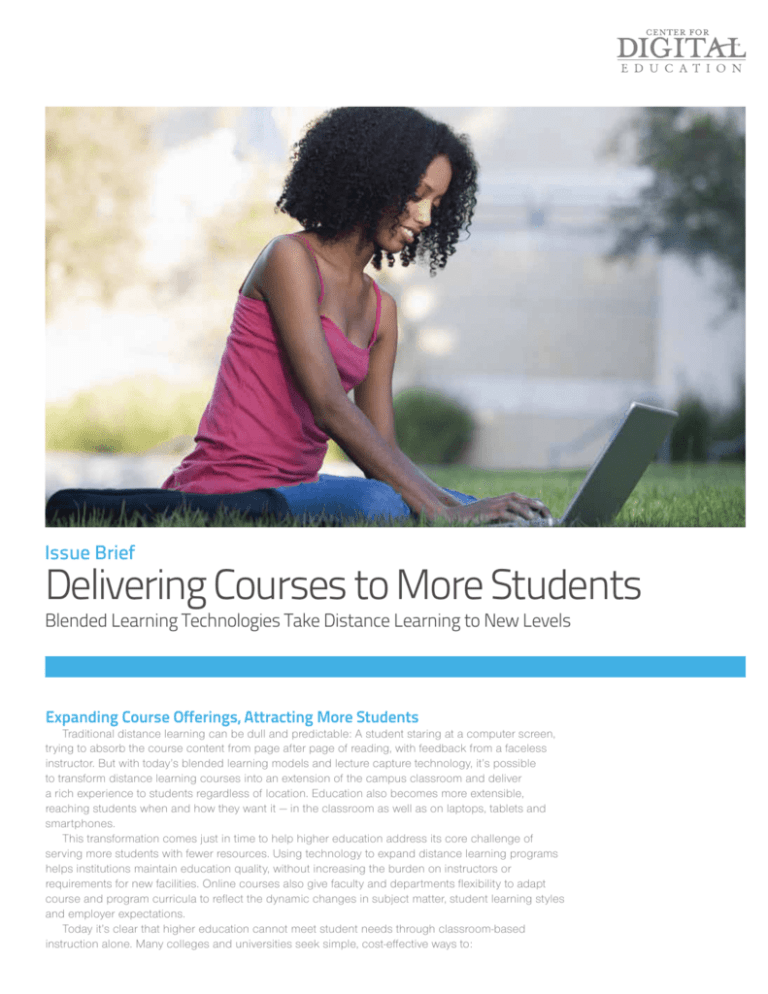
Issue Brief
Delivering Courses to More Students
Blended Learning Technologies Take Distance Learning to New Levels
Expanding Course Offerings, Attracting More Students
Traditional distance learning can be dull and predictable: A student staring at a computer screen,
trying to absorb the course content from page after page of reading, with feedback from a faceless
instructor. But with today’s blended learning models and lecture capture technology, it’s possible
to transform distance learning courses into an extension of the campus classroom and deliver
a rich experience to students regardless of location. Education also becomes more extensible,
reaching students when and how they want it — in the classroom as well as on laptops, tablets and
smartphones.
This transformation comes just in time to help higher education address its core challenge of
serving more students with fewer resources. Using technology to expand distance learning programs
helps institutions maintain education quality, without increasing the burden on instructors or
requirements for new facilities. Online courses also give faculty and departments flexibility to adapt
course and program curricula to reflect the dynamic changes in subject matter, student learning styles
and employer expectations.
Today it’s clear that higher education cannot meet student needs through classroom-based
instruction alone. Many colleges and universities seek simple, cost-effective ways to:
•Begin or expand distance learning programs to stay
competitive and capture more tuition revenue
•Serve changing student needs and demographics
•Help faculty deliver online courses that are relevant, current
and engaging
•Enroll more students within the limits of existing classroom
space
“A lot of students take our online classes when
they go home for the summer. This lets them stay
within their familiar University of Toledo program
instead of taking an unfamiliar class at a college that
is closer.”
Claire Stuve, Educational Technologist, University of Toledo
But how can an institution avoid creating distance learning
courses that become the neglected stepchildren of on-campus
programs? The answer lies in using blended learning
technology to blur the lines between in-class and distance for
both the instructor’s delivery and the student’s participation.
A blended learning model, with lecture capture technology
at its core, can help institutions provide high-quality distance
learning courses quickly and affordably. Blended learning courses
meet the needs of both distance and local students, as well as
institutional strategies for delivering high-quality academics, even
as budgets decline and competition offers students more, faster
and often lower-cost options for meeting their education goals.
In a recent survey of students, 84 percent of respondents stated
that the ability to study both online and in class improves their
understanding of course concepts.1
“Our online classes are serving more adult learners who often
find it difficult to schedule classes around one or two jobs,” says
Claire Stuve, educational technologist at the University of Toledo
in Ohio. “But lecture capture eases students’ fears about being
too much on their own in an online class.”2
Traditional Distance Learning and Today’s
Blended Learning: Understanding the Differences
Delivering courses to distance students has come a long way from the traditional technologies
used, including videoconferencing and information, podcasts and videos uploaded to static websites.
Yet the blended learning model builds upon and enhances current delivery methods, content and
technologies for distance learning. This model helps educational institutions make more courses
available to more students in more ways, in an economical approach that matches the realities of
budgets and program organization.
Course delivery methods. A blended learning course can encompass live or recorded lectures
to support traditional online-only learning and virtual study groups. It also can be delivered in a flipped
model that mixes classroom and online instruction with individual work (online or offline) and virtual
study groups.
Course content. Much, if not all, content that is currently delivered in distance learning courses
is suitable for blended learning. But some classes may not be suitable, such as those involving
in-class activities and discussion for learning instead of information transfer through a lecture.
For courses such as these, a technology which includes participation tools would be necessary.
Additionally, some courses may not be appropriate for lecture capture because of the nature of the
content, or for privacy or cultural reasons.3
Technologies. To remain competitive in the expanding marketplace for distance learning, an
institution needs an internal, enterprise-wide solution for course capture and management.4 Look for a
solution that:
•Minimizes demand on instructors and the IT department for ongoing operation, maintenance
and user support of the lecture capture system as well as related tools for publishing and course
management
•Enables scalability and integration with content management systems to easily accommodate more
students, content and courses
•Provides simple, PC-based personal recording tools for instructors to create short videos and
podcasts that integrate with other online content for the course
•Allows the institution to apply its branding to content and interfaces and allows students to
personalize course content for their needs
Blended Learning Advantages for Delivering
Distance Courses
Together, the blended learning model and lecture capture
solutions offer notable benefits for higher education institutions
that want to solve the conundrum of “so many students, so little
space.”
Serve more students and reach new markets. Blended
learning courses can alleviate “bottleneck” courses — those
required for graduation, where enrollment demand exceeds
available seats. Students who experience delays in accessing
these courses may not graduate on time, which may prompt them
to change schools or simply drop out.
With distance courses, an institution’s market can also expand
to cover the world, as well as to serve students with special needs
or those who may not be able to attend on-campus classes.
Distance courses can also capture more tuition fees from current
students. “A lot of students take our online classes when they
go home for the summer,” says Stuve. “This lets them stay within
their familiar University of Toledo program instead of taking an
unfamiliar class at a college that is closer.” At the University of
Toledo, it is possible for students to complete all courses online in certain programs.
Instructor benefits. Recorded lectures and learning modules can be a tremendous time-saver
for faculty even if they don’t have a distance learning course. By requiring students to watch a recorded
lecture before class, an instructor can focus on discussions and interactive learning activities during
the session. A lecture recording that is stored in the content management system can be better and
more easily integrated with other content than is possible with videos that are simply uploaded to
popular online sites. And with the ability to reuse content, instructors can easily update and improve a
course for a new term.
Student benefits. Compared to traditional online-only distance courses, the benefits to students
(and their institutions) include:
•Increased achievement, satisfaction, retention and likelihood of on-time graduation
•The ability to view a lecture as it was presented in the classroom and use it to prepare for exams,
lab sessions and other learning activities
•Easier integration of distance students with their cohort in comparison to viewing standalone
podcasts, Web videos and online documents
•The ability to make learning more social through participation in virtual study groups organized for
each online course
The Proof is in the Test Results
Do all of these new technologies and new ways of learning really make a difference where it
counts — in student test scores? Initial studies indicate that the answer to this question is “Yes.”
Researchers in a study conducted by the University of Texas at Austin found, “For all of the courses,
students who viewed the pre-recorded lecture and participated in the class activity did better on the
post-test compared to students who did not view the lecture capture but participated in the class
activity.”5 Another study, conducted by the University of Sussex, determined that recorded lectures
and other content improved test performance for some students.6
Expanding Distance Learning Offerings at the University of Toledo
A strong online initiative at the University of Toledo in Ohio has produced a new distance learning
department and 400 new online courses in the 2011-2012 academic year alone. With the University’s
goal of offering online courses across the curriculum, each faculty member is now required to teach at
least one course online.
Lectures recorded with capture technology are a core element of the online courses. The University
has installed lecture capture units in varied classroom types and has licensed personal capture
technology that allows instructors to record short videos that supplement the classroom presentations.
The expansion of online courses with recorded lectures has been well received by faculty and
students. Faculty like the lecture capture technology because it does not involve equipment setup or
file uploads. They also report not seeing as many students during office hours or receiving as many
emails with basic questions.
A strong online
initiative at the
University of Toledo
has produced a new
distance learning
department and 400
new online courses
in the 2011-2012
academic year alone.
Each faculty member is
now required to teach
at least one course
online.
“Having lecture capture technology lets us create more of a
community feel in an online course, which definitely improves the
student’s experience,” says Stuve. “In the classroom not everyone
gets a chance to talk, but everyone gets a voice online.”
The University of Toledo as an institution benefits from the
ability to easily increase enrollments and gain more revenues
through online classes. And as more students enroll for distance
learning courses, the university expects improved student grades
and retention.7
Conclusion
Colleges and universities are entering a new era where more
student learning takes place outside the classroom than within
it. This learning is enriched by new instructional technologies
and online interaction that enables the spectrum of in-classroom,
distance and blended learning.
Students benefit from the ability to choose the mix of course
types that best fits their learning style and available time. Institutions can educate more students, with
more flexibility, while making the best use of available faculty, facilities, technology infrastructure and
academic support resources. An institution and its students can both benefit from a learning model
that helps more students graduate on time and prepare for careers in a changing economy.
The University of Toledo’s Stuve sums it up perfectly: “Students have opportunities they wouldn’t
have if they weren’t able to access distance learning courses,” says Stuve. “I really think distance
learning is the wave of the future and I’m excited to see where it goes.”8
“Students have
opportunities they
wouldn’t have if they
weren’t able to access
distance learning
courses. I really think
distance learning is
the wave of the future
and I’m excited to see
where it goes.”
Claire Stuve, Educational
Technologist, University of
Toledo
Endnotes
1.
2.
3.
4.
5.
6.
7.
8.
Echo360 White Paper, “Blended Learning Technology: Connecting with the Online-All-the-Time Student,” 2012, http://resources.echo360.com/
student-whitepaper-2012-pr.
Center for Digital Education interview with Claire Stuve conducted on July 9, 2012
Wainhouse Research White Paper, “Blended Learning Technology: Navigating the Challenges of Large-Scale Adoption,”
http://resources.echo360.com/adoption-pr
Ibid.
University of Texas at Austin, Grant Report, “Lecture Capturing to Transform Student Learning Opportunities in Large Classes,”
www.echo360.com/wp-content/themes/echo360_v2/downloads/UTAustin_final_report.pdf
University of Sussex Me2 U Project, www.sussex.ac.uk/elearning/audioandvideo/me2u
Center for Digital Education interview with Claire Stuve conducted on July 9, 2012
Ibid.
®
More than one million students in 6,000 classrooms at 500 institutions across 30 countries rely on
Echo360 technology to enhance their educational experience. Echo360 digitally records and shares
instructional content live and on demand, allowing institutions to reach more students while lowering costs.
Through Echo360, students engage with their peers through collaborative tools and review information from
instructors online, at their convenience and across various devices. The company has been recognized with
a Product Line Strategy of the Year Award from Frost & Sullivan, is CSIA-certified for outstanding customer
service, and was named a Visionary Vendor in Educational Technology by IT research firm Basex.
For more information, visit www.echo360.com.
© 2012 e.Republic. All rights reserved.



